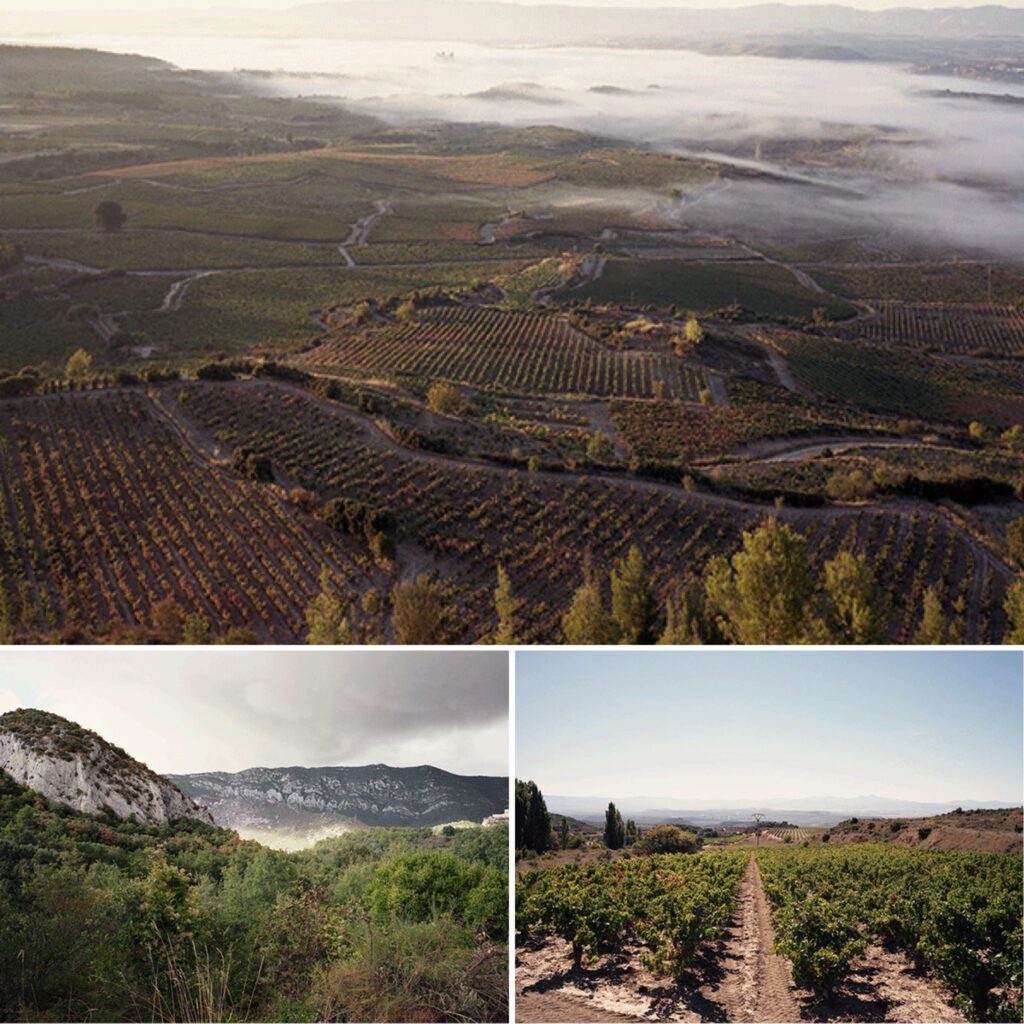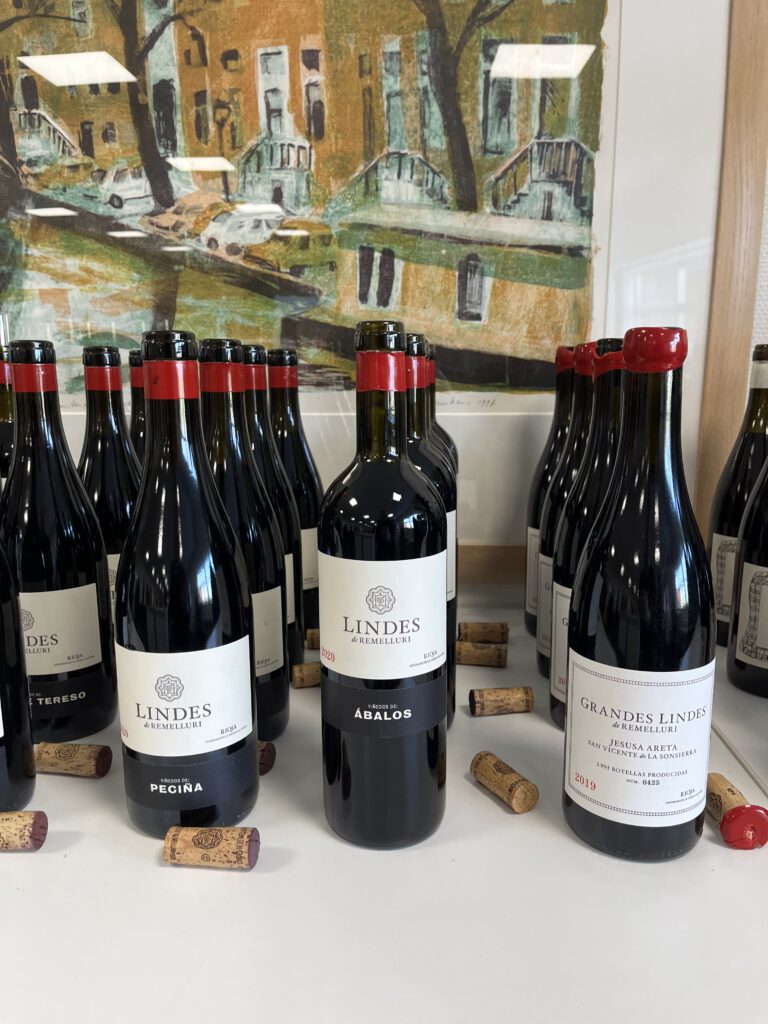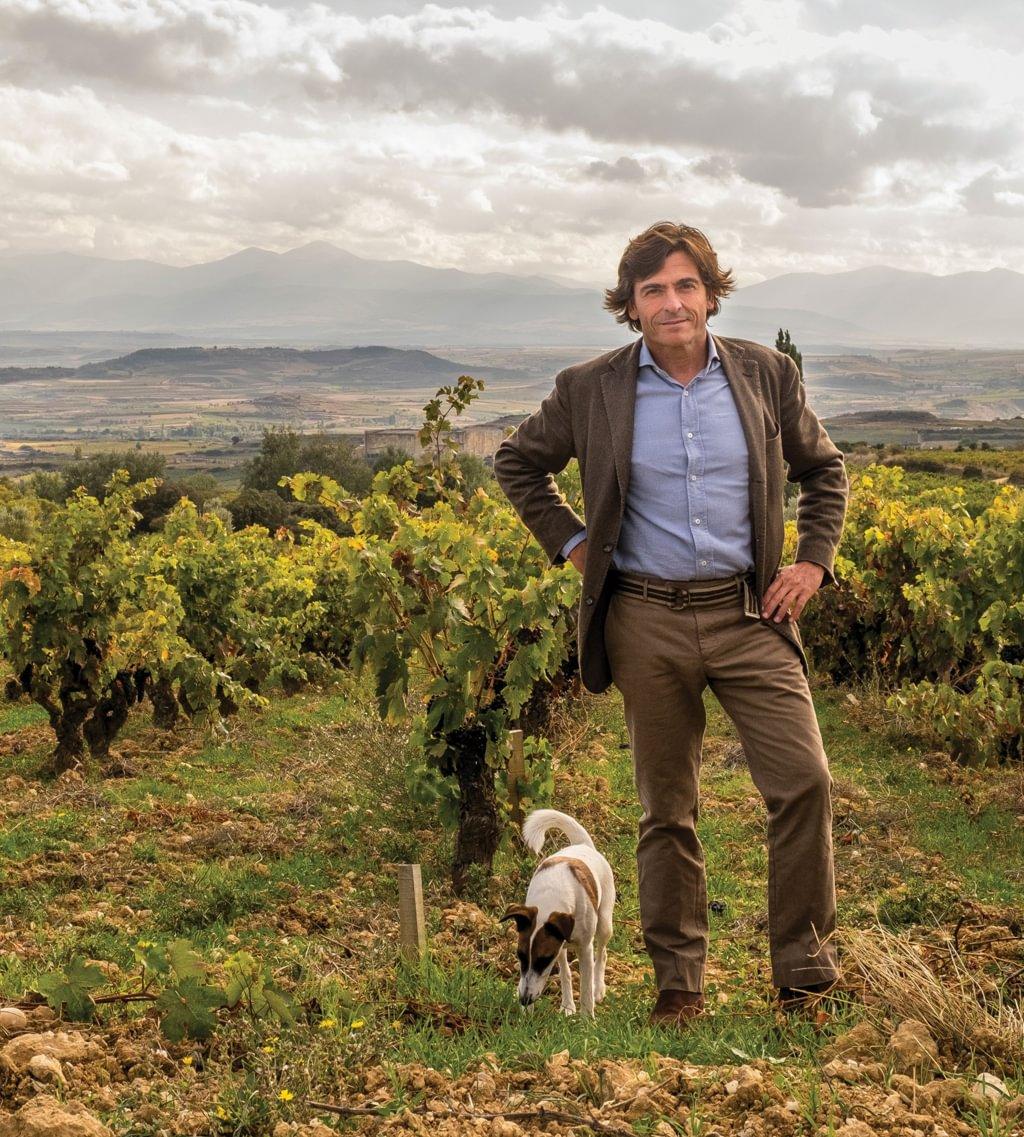Lindes de Remelluri – Telmo Rodríguez Redefining Classical Rioja.
A couple of months ago, our Hermen tasted cult wine Las Beatas, the 100 Parker points Rioja out of the hands of legendary winemaker Telmo Rodríguez. The wine was served by Pallas Wines’ senior buyer Joep Speet Magister Vini. When Pallas recently invited us to meet Telmo Rodríguez himself, Hermen did not have to think twice. He drives to Pallas headquarters in Waddinxveen and meets the so-called driving winemaker. Rodríguez reveals the ins and outs of his exiting Pegaso project in Sierra de Gredos and we taste the brand new Lindes de Remelluri wines. Please travel along with one of the most inspiring winemakers we have met so far.
Walking off the Beaten Track
After finishing his study at the university of Bordeaux, Telmo Rodríguez gains experience working with several talented winemakers, among them world famous late Rhône winemaker Auguste Clape. Once returned to Spain, he starts working at his family winery called La Granja Nuestra Señora de Remelluri. Telmo’s father Jaime Rodríguez bought the winery in 1967, a former 14th century monastery in Rioja Alavesa.
The high elevated vineyards of Remelluri are located on the southern oriented sheltered slopes of the Sierra de Toloño mountains. Telmo Rodríguez sees the potential of the Remelluri vineyards, but could not reconcile the prevailing practises those days. ‘When I started at Remelluri, Spain was specialized in shitty wines. My father forbid me to make fine wines, because the market demanded cheap and over oaked Rioja.’ Telmo refuses to fulfil his father’s wish and starts to go his own way. First at Remelluri and after a while apart for his father’s business. Telmo clearly is not afraid to walk off the beaten track. He specializes in restoring abandoned vineyards in various Spanish production areas. From his home in Madrid he drives to his projects throughout whole Spain, earning him the nickname ‘the driving winemaker’.
Pegaso
One of these exciting projects is called Pegaso. The vineyards of the Pegaso project are located in Sierra de Gredos, a 1.200 metres high mountain range on the west side of Madrid. When Telmo Rodríguez arrives in Sierra de Gredos, the area is deserted. He buys a great historic vineyard for next to nothing. ‘It was like looking at an abandoned Le Montrachet. The only thing we had to do was to make wine.’ But that was easier said than done ‘The problem is not to buy the vineyard. The problem is to work it. The costs of cultivating the vineyard are about € 4,50 per kilo.’ These high production costs forces him to sell the Pegaso wines at great expense. ‘That was very difficult to explain to the market. I was selling an unknown wine at a higher price level than famous Riojas.’
Thanks to the hard work of Telmo Rodríguez, and his people, the Pegaso project succeeded. The project contributed to the rebirth of Sierra de Gredos. ‘Sierra de Gredos is run by young and passionate people now, all driven by the same goal: producing the most amazing Garnacha wines in the world. The high elevated old Garnacha vines on the granite soils of Sierra de Gredos produce incomparable unique wines.’
We tasted a selection of the Pegaso wines, below you find our findings and ratings.

Telmo Rodríguez Pegaso Zeta 2021
The fragrant floral and fruit forward bouquet is dominated by fresh red fruits, sweetish berries and a touch of bramble and rosehip. The well-balanced feminine wine is light and mineral and filled with juicy red fruits. Pegaso Zeta offers a pleasant introduction to Garnacha from Sierra de Gredos on very reasonable price level. Great value for money.
We award this wine with a 93-point DWA score.
Telmo Rodríguez Pegaso Barrancos de Pizarra 2021
Barrancos de Pizarra comes across more serious. The fruit tends towards more blue and black coloured fruits, next to hints of red fruits. The bouquet is filled with herbal and earthy aromas. The wine is beautifully concentrated – without getting weighty – and backed up by an attending yet refined structure and beautiful acids. Layers of delicate and juicy red and black fruits pass into a long-lasting mineral aftertaste.
We award this wine with a 94-point DWA score.
Telmo Rodríguez Pegaso Granito 2021
Although Granito in this youthful stage is hiding itself a bit, we get a glimpse of its true character. Granito opens up slowly, showing warm herbal flavours, graphite and carefully opening layers of red fruits. Granito is defined by its granite core and delicate texture, giving the wine structure, complexity and personality, surrounded by layers of beautiful ripe red fruits, all together leading into a long-lasting aftertaste.
We award this wine with a 95-point DWA score.
Telmo Rodríguez Pegaso Arrebatacapas 2020
Arrebatacapas is the culmination of the Pegaso project. It is a true fine wine, in every single way. The wine is simultaneously full bodied and delicate. It is giving a lot of pressure without any weight. Floating concentration is aided by a thrillingly energizing mineral core. Compact power goes along with great complexity. Magic floating fruit is flowing seamlessly into an endlessly lasting aftertaste. Outstanding wine.
We award this wine with a 96-point DWA score.

Lindes de Remelluri
In 2010 Telmo is asked by his brother to come over to help him run Remelluri. Telmo agrees, but on his own conditions. He wants uncompromising execution of his ideas. Executing ideas of Telmo Rodríguez implies breaching established systems. Together with his sister Amaia, Telmo transforms Remelluri into a high-quality terroir driven winery. He makes a clear delineation between wines from own Remelluri vineyards and wines from purchased grapes. Estate wines are made from own grapes. To continue the collaboration with the growers, Telmo initiates a négoce project called Lindes de Remelluri.
He sees through the finiteness of the system of underpaying growers and starts to pay his 25 growers far above average. Where other wineries only pay an alarming price of 50 eurocents per kilo grapes, Telmo Rodríguez pays his growers up to 3,50 euros per kilo. ‘When you don’t pay a fisherman well, he won’t get out of his bed early catching the best fish. The same goes for growers. I want to send a very clear message to them: I am helping you to become the best grower.’

Swimming Against the Tide
Telmo Rodríguez is not afraid voicing his opinion. According to Rodríguez Rioja is ravaged by a systemic error. The error of the missing link between the wine and the land. ‘In Rioja they tell the fairy tale the origin of wine is not in the vineyard. The vineyard is not important, the work in the vineyard is not important and the grapes are not important.’ Telmo Rodríguez is visible angry and worried about this development. ‘It is a very decadent approach. At the end of the day everything will become completely generic.’
Telmo Rodríguez outlines the problem of the current system by making a comparison to Burgundy. ‘Ask several wine professionals to name five villages in Burgundy and they will easily sum up the villages and describe the profile of the wines. Ask the same professionals the same question in relation to Rioja and there will be a deafening silence.’ That is where Lindes comes around. Lindes means boundaries in Spanish. With Lindes, Rodríguez starts defining the viticultural borders of the villages of Rioja. As maps of wine regions demonstrate, determination of borders promotes clarity and understanding. ‘When I saw the map of Barolo for the first time, I began to understand Barolo.’
Telmo Rodríguez starts mapping Rioja, groups grapes by villages and vinifies them separately. Neutral vinification techniques are used to promote pure grape and terroir expressions. ‘The idea of Lindes is the protagonist is not the winemaker. The protagonist is the terroir. I hate the idea that oak is seen as an important element of Rioja. Oak is a mask, destroying the differences that we should feel in the wines of the world.’
Back to the Roots
All of the choices of Telmo Rodríguez are based on a deep sense of history. Before he starts a project, he conducts in-depth historic research to the villages. ‘For example, I want to know how many cellars a village has had in the past. A village with a lot of cellars had an amazing vocation of agriculture.’ Driven by this deeply rooted historical awareness, he also reintroduces field blends. Field blends are multiple grape varieties planted intertwined in one vineyard. The grapes are picked at the same moment. ‘Field blends are the oldest expression of viticulture. We have to face our history and recover the beauty of it.’ Field blends promote biodiversity and disease resistance. Opponents of field blends argue that grapes are not ripening at the same moment, resulting in a wine made out of under ripe and overripe grapes. It may be objected to this that studies show that the difference in ripening of the grapes decreases when they originate from a field blend. Also, field blends can contribute to an increase in complexity in the wine.
Lindes de Remelluri – The Foundation
Telmo Rodríguez finds out Labastida has known a thriving wine scene in the 17th and 18th century. ‘The quality of vineyards of Labastida was amazing in that time. Old documents showed me that Labastida had times of famine, just because of the fact there were more vines than there was corn.’ Telmo Rodríguez sees Labastida as the hometown of Lindes. It is Labastida where he restored an abandoned palace to the Lindes winery. Lindes first cuvee is Labastida, followed by San Vicente de la Sonsierra.
The biggest fear of Rodríguez was that the cuvees of Labastida and San Vicente de la Sonsiera would taste the same, this turned out to be unfounded. Although the villages are located next to each other, the wines are tasting different. The Lindes wines are classical Rioja style wines, in the initial sense of the word. Both wines are dark and powerful, but also pure, honest and well balanced. And most importantly they are expressing terroir. ‘To reveal the taste of the villages of Rioja is a real privilege.’ Lindes redefines classical Rioja.
We tasted the complete portfolio of Lindes de Remelluri wines, below you find our findings and ratings.

Lindes de Remelluri – Labastida 2020
Labastica is marked by beautiful pure and fresh purple fruits. The fruit is ripe and mouth filling and proper acids foresee in sufficient preciseness and freshness. The wine is well structured and the long-lasting aftertaste is dominated by pure herbal flavours.
We award this wine with a 94-point DWA score.
Lindes de Remelluri – San Vicente de la Sonsierra 2020
San Vicente de la Sonsierra is distinguished by its fresh, floral and uplifting fruit dominated flavours. The powerful wine is pleasingly juicy, expressive and perfumed. Is graced with incredible exciting acids and a long-lasting aftertaste.
We award this wine with a 94-point DWA score.
Lindes de Remelluri – New Kids on the Block
From now on, the villages of Salinillas de Buradón, Rivas de Tereso, Peciña and Ábalos have been newly added to the Lindes project. To start learning the differences between the villages, Telmo Rodríguez applies a neutral vinification. ‘In 2020 you see the pure expression of the grapes. You don’t see the winemaker.’ After fully understanding the terroir, vinification of future vintages will be customized to the individual wines.
Salinillas de Buradón 2020
Salinillas de Buradón is a small village at the Atlantic side of the mountains. Salinillas refers to the high amount of salt in the red and blue coloured soils. Salinillas de Buradón 2020 is incredibly linear and precise. The structure feels compact and granitic – almost metallic. Around this iron core we find nuanced fruit flavours including raspberry and currant. The wine shows proper concentration and pressure. Very exciting wine.
We award this wine with a 94-point DWA score.
Lindes de Remelluri – Rivas de Tereso 2020
The small village of Rivas de Tereso is located at the foot of the mountains. Higher altitudes, rocky soils and a strong northern wind makes this place suitable for Garnacha. In comparison to other Lindes wines, Rivas de Tereso contains a higher amount of Grenache. The wine shows beautiful floral and sweet red fruit dominated flavours. Mouth fulling crystal clear bramble fruit is worn by a silky, gripping texture and graceful acids. Rivas de Tereso is a highly pleasurable and elegant wine.
We award this wine with a 94-point DWA score.
Lindes de Remelluri – Peciña 2020
The Peciña vineyards are located in a small amphitheatre on an altitude of 650 meter above sea level. The soil is chalky and rocky. Peciña 2020 strikes us as one of the most structured wines in the Lindes series. Floral, herbal, meaty, linear, powerful, grainy tannins, solid and length are keywords we noted. The wine is hiding potential and will open up with time.
We award this wine with a 94-point DWA score.
Lindes de Remelluri – Ábalos 2020
Ábalos is located in a more open part of the valley. The vineyard is located 500 meters above sea level, on calcareous marlstone and old limestone. Ábalos offers a lovely balance between ripe dark fruits and earthy flavours. The fruit is ripe yet energetic, round, juicy and crunchy. On the other hand, the wine offers refined dark and herbal flavours. Powerful yet refined tannins do provide in good structure. Classy acids leave a clean mouthfeel.
We award this wine with a 94-point DWA score.

Lindes de Remelluri in Optima Forma
Telmo Rodríguez wears his heart on his sleeve. ‘My ambition is to make the best Rioja.’ Scoring 100 Parker points on Las Beatas proves he is not getting too big for his britches. But there is more than Las Beatas. There is Grandes Lindes de Remelluri for instance. The story of Grandes Lindes goes way back. The wine is made out of very old vines. The family of Jesusa Areta kept the vines planted by their great-grandparents. Telmo Rodríguez could not bear to blend the wine from this exceptional vineyard with wines from other vineyards. So, he made a single vineyard wine out of it and kept it as a family treasure.
Until now: Grandes Lindes de Remelluri has been put on the market. But you have to be quick: only 2.993 bottles are produced. And there is one bottle less now: we tasted Grandes Lindes de Remelluri 2019 and we enjoyed every sip of it.
Lindes de Remelluri – Grandes Lindes 2019
The deep purple coloured wine is showing its greatness right from the start. The bouquet is amazingly complex and deep. We notice various shades of purple fruits: from pure and uplifting to comfortable ripe. The fruits are accompanied by layers of fresh forest floor, tobacco leaf and warm oriental spices. The attack is mouth filling and comfortable, followed by an amazing powerful and mineral structure. The wine is simultaneously electrifying energetic and incredibly well balanced. The very long-lasting aftertaste leaves a clean and elegant impression, making you yearn for the next sip. Grandes Lindes 2019 has a great upward potential: patience will be rewarded. This truly is a classic Grand Cru Rioja.
We award this wine with a 96-point DWA score.

Legal Anchoring of Contrarian Visions
Telmo Rodríguez redefines Rioja. Amongst others he started an unstoppable movement to terroir driven wines. Rioja’s Regulatory Council is not impervious to these developments. Since 1999 wineries are allowed to name one of the 144 villages on the label (‘Vinos de Municipio’) and since 2017 these villages may have a greater visibility in terms of font size. Single vineyards with unique characteristics linked to the terroir may bear the name ‘Viñedo Singular’. On 15th of February 2024 DOCa Rioja’s Regulatory Council approved regulation that changed the name Vino de Municipio into ‘Vino de Pueblo’. It also allows the term ‘Viñedo en’ (vineyard in) on the label, intended for wines made exclusively from described vineyards.
The Youth has the Future
Telmo Rodríguez gave us a thoughtful glimpse into the past and present of Rioja. How does the mastermind see the future of Rioja? ‘I’m 61 years old now. I have been working 30 years in Spain. In those 30 years we did more than we did in the last 300 years. Spain was sleeping, but is waking up now. Nowadays the story of Rioja is about small growers and young people. Their wines already are better than what we did in Rioja in the last 50 years. And the best has yet to come…’.
This article is written by our own Hermen Jansen. We thank the team of Pallas Wines for facilitating the conditions to enable Telmo Rodríguez sharing his inspiring thoughts. The Lindes de Remelluri wines are available in the Dutch market through selected retail and hospitality partners of Pallas Wines. Picture credits: Dutch Wine Apprentice, Pallas Wines and Telmo Rodriguez.

